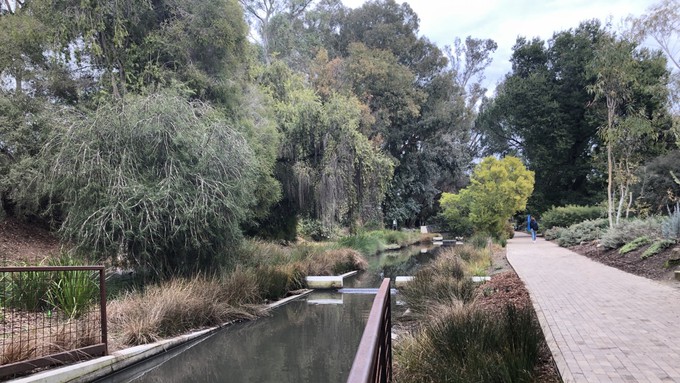
Lost trees will be replaced by climate-ready alternatives

The UC Davis Arboretum and Public Garden encompasses the entire campus. It is known for its variety of well-cared-for trees, as shown in this photo from 2020. New plantings to replace fallen ones will be chosen based on adaptability to climate change. Kathy Morrison
Four weeks since wicked winds brutally whipped our urban forest, we’re still cleaning up. Work crews are still tackling fallen trees and limbs. The sound of chainsaws drowns out traffic and birdsong.
Many parks and landmarks lost numerous trees. That includes the UC Davis Arboretum and Public Garden.
By its own count, the arboretum – which encompasses the whole UC Davis campus – lost 75 mature trees on New Year’s Eve and during the subsequent storms.
“Considering our campus urban forest tree population is close to 20,000, the losses might have been much worse,” wrote Katie Hetrick, the arboretum’s communications manager, on its website.
It wasn’t just downed trees, but limbs and other debris. The result was quite a mess.
“The cleanup effort undertaken by all of the teams in the Arboretum and Public Garden – Grounds and Landscape Services, Putah Creek Riparian Reserve and the Arboretum – is massive, includes outside contractors, and will take months to recover from,” Hetrick wrote.
Helping to prevent worse losses was the arboretum’s continuous tree stewardship. Because they’re part of an arboretum, all trees (as well as shrubs, perennials and other plants) are carefully tracked and monitored from the day they’re planted. Problems are tackled before they have a chance to create havoc.
Because of that constant care, the arboretum’s trees are especially healthy. That’s what makes this recent devastation particularly shocking. One possible reason: A shift in wind direction. Local trees have decades of resistance to southern winds; these gusts hit from the east.
The recovery will include replanting, but not necessarily the same trees.
“While the weather-related havoc wrought across campus is disheartening, it is also important to understand that our campus is not just reacting, we planned for this uncertain future and are already taking action,” Hetrick said.
New trees will not only add beauty and shade, but more climate resiliency. UC Davis’ Campus Tree Renewal Program plans to create a legacy of trees that will last 100 years or more.
As part of this effort, students trialed about 45 tree species in test sites on campus. The top performers earned permanent spots for their species in UC Davis’ future.
That group includes a lot of familiar oaks – valley oaks, live oaks and cork oaks – plus drought-resistant Texas red oak. The success of the Texas red oak prompted students to test more Texas natives.
As crews continue the clean-up, the arboretum is now raising funds to support its tree-planting efforts. (See the links on the arboretum website.)
Hetrick noted, “We are devastated by the loss, but our current efforts to transition our landscapes to be climate-ready offer hope.”
For more: https://arboretum.ucdavis.edu.
Comments
0 comments have been posted.Sacramento Digs Gardening to your inbox.
Sites We Like
Garden Checklist for week of April 14
It's still not warm enough to transplant tomatoes directly in the ground, but we’re getting there.
* April is the last chance to plant citrus trees such as dwarf orange, lemon and kumquat. These trees also look good in landscaping and provide fresh fruit in winter.
* Smell orange blossoms? Feed citrus trees with a low dose of balanced fertilizer (such as 10-10-10) during bloom to help set fruit. Keep an eye out for ants.
* Apply slow-release fertilizer to the lawn.
* Thoroughly clean debris from the bottom of outdoor ponds or fountains.
* Spring brings a flush of rapid growth, and that means your garden needs nutrients. Fertilize shrubs and trees with a slow-release fertilizer. Or mulch with a 1-inch layer of compost.
* Azaleas and camellias looking a little yellow? If leaves are turning yellow between the veins, give them a boost with chelated iron.
* Trim dead flowers but not leaves from spring-flowering bulbs such as daffodils and tulips. Those leaves gather energy to create next year's flowers. Also, give the bulbs a fertilizer boost after bloom.
* Pinch chrysanthemums back to 12 inches for fall flowers. Cut old stems to the ground.
* Mulch around plants to conserve moisture and control weeds.
* From seed, plant beans, beets, cantaloupes, carrots, corn, cucumbers, melons, radishes and squash.
* Plant onion sets.
* In the flower garden, plant seeds for asters, cosmos, celosia, marigolds, salvia, sunflowers and zinnias.
* Transplant petunias, zinnias, geraniums and other summer bloomers.
* Plant perennials and dahlia tubers for summer bloom.
* Mid to late April is about the last chance to plant summer bulbs, such as gladiolus and tuberous begonias.
* Transplant lettuce seedlings. Choose varieties that mature quickly such as loose leaf.